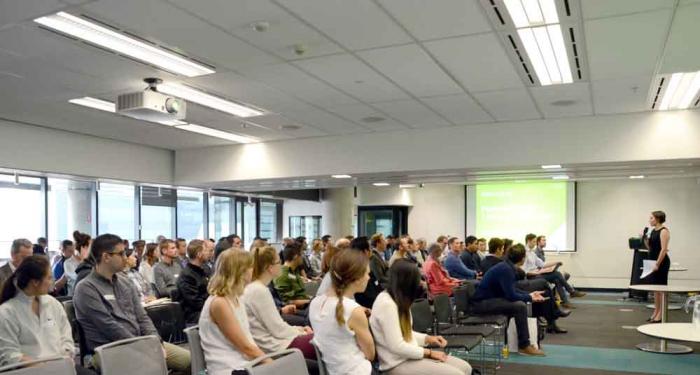Aurecon and Monash University recently hosted a Passive House ‘Under Construction’ workshop in Melbourne to discuss the Passive House Building Standard, high performance building envelopes, airtightness, mechanical ventilation and construction sequencing.

Johanna Trickett speaking at the Passive House 'Under Construction' workshop
According to industry experts who presented at the workshop, complying with the Passive House Building Standard can result in improved building outcomes, such as greater levels of thermal comfort, a healthier work environment, lower energy costs and increased building structure longevity.
Aurecon ESD consultant Johanna Trickett says passive house construction provides high comfort and quality of life without sacrificing energy efficiencies or increasing costs.
“Australia and New Zealand are at the start of this journey and due to initial obstacles and challenges, such as a knowledge gap in industry as well as availability of products and materials. The Passive House Building Standard will likely incur greater costs than will be the case once this standard becomes normalised. However, the passive house benefits of user comfort and energy efficiency outweigh the costs.”
Pro Clima Australia building science manager Jesse Clarke says the Passive House Building Standard can also solve issues of moisture and mould in cooler climate locations, and exacerbated summer cooling issues in warmer climate locations.
“The Passive House Building Standard has solved both of these issues by delivering comfort through control over thermal fluxes over the building envelope, combined with adequate thermal bridging. This provides stability of indoor conditions,” says Jesse.
“Through airtightness considerations and implementation of the building standard, we see a balance in the moisture flows with the heat within the building envelope which results in a healthy, dry, high performing building.”
Passive house construction requires very high levels of building fabric airtightness to provide the thermal comfort and low operating costs expected. Therefore, building envelope and services must be successfully considered at the same time during the design process.
If this is implemented effectively, passive house construction can achieve efficiencies up to between 80%-90% for high quality heat recovery units. This allows for a significant reduction in heating and cooling plant capacity, energy consumption and operational costs.
Fantech intelligent ventilation solutions engineer Joel Seagren says the improved health is achieved from factors such as enhanced indoor air quality (low CO2, volatile organic chemicals and other contaminant levels) and the greatly reduced requirement for supplementary heating and cooling.
“This reduces the risk of allergy and dehumidification effects that can be associated with HVAC air delivery systems. While ventilation requirements are well prescribed for some building classes (but not all), the importance of correct ventilation is increased as there can be no reliance on fresh air infiltration via the building fabric. While this is not explicitly included in the design, it can have a meaningful impact in terms of indoor air quality, condensation removal, and potentially mould growth,” says Joel.
“Direct ventilation, mechanical or natural, increases the required capacity of heating and cooling equipment when outdoor air temperatures, or humidity levels, are outside comfort bands, which is typically most of summer and winter depending on the climate zone.”